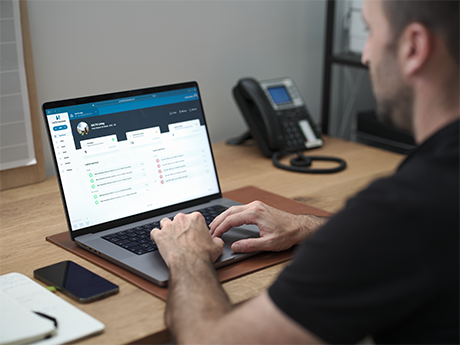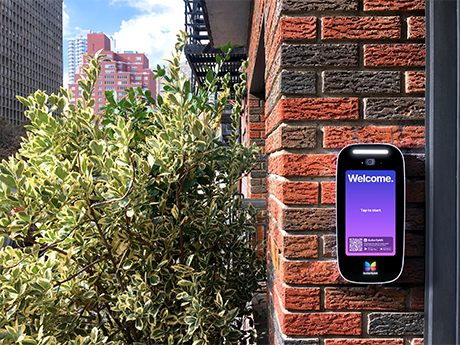Security is a top priority in the multifamily industry. Monitoring and controlling access to a property protects owners and their residents from the impacts of violent crime, theft, vandalism and trespassing.
The benefits of an effective security, monitoring and access system run deep. “Access control is not just about security,” says Roger Solomon, a senior associate at Trio Advisory Group. The company offers consulting services on access control, video surveillance and other technologies for commercial real estate properties.
“Access control is also about ensuring convenience for residents and staff, enhancing the overall quality of life at a community and future-proofing assets against technological advancements,” says Solomon. “The right access control system will add real value to both the property and for its residents.”
The type of access control system an owner-operator installs can increase operational efficiency and net operating income, free up staff, reduce costs and lower resident turnover rates.
Locks and Keys Still Popular Option
The benefits of an old-fashioned lock-and-key system are clear. Mechanical locks are weatherproof and do not require electrical power or Wi-Fi connectivity. Key-controlled locks also are relatively affordable to install.
According to a report from the National Apartment Association (NAA), 53 percent of property management professionals exclusively use mechanical keys. Traditional key users reported that they preferred metal keys because they are more reliable and familiar.
The survey collected responses from 202 property managers. KeyTrak , a College Station, Texas-based company that creates technology to track keys and assets, conducted the survey in partnership with NAA.
Mechanical locks do, however, come with several downsides. Most notably, physical keys can be copied, which can put an entire property in danger of unauthorized entry and theft. When keys are lost or stolen and duplicated without permission, owner-operators must pay to have the locks changed, which can be a costly and time-consuming inconvenience.
While it may be relatively inexpensive to replace hardware on a door once or twice, the cost of rekeying doors at an entire property will quickly begin to add up.
Reprogramming an electrical lock is easier and less costly than rekeying a mechanical one. “Here’s a story that I was told,” says Preston Grutzmacher, residential business leader at Salto Systems, which provides access control and electronic lock solutions to a variety of industries, including commercial real estate.
“A property manager at a 150-unit condo building made a mistake and accidentally left the property with a master key that would have opened every door and every unit in the property,” says Grutzmacher. “Later that evening, her car was broken into, and the key was stolen. So there had to be an emergency rekey of the building and all the units over the weekend. It essentially ended up costing tens of thousands of dollars to replace a $2 mechanical key.”
Traditional locks also fall short for property managers in search of a more advanced security solution. For instance, an electronic lock can provide a digital log of everyone who has entered an apartment unit or amenity space.
Of the survey respondents who said they use electronic locks in some capacity, 48 percent said that they chose smart locks because they provide better security than traditional locks.
Furthermore, 40 percent of property managers who use electronic locks added that they also store their fobs and access cards in an electronic key-control system.
Owners Have Buffet of Electronic Security Options
There are a variety of electronic access control systems available to developers and operators.
Keypad readers, for instance, are a simple type of electronic lock that require a PIN code. Residents and property staff can simply enter their code to open gates, access units and enter amenity spaces. PIN codes can be unique to each resident, or they can be the same across the property.
Radio frequency identification (RFID) systems work similarly to keypad readers. This type of lock uses electromagnetic fields to scan either a key card or a key fob to unlock the door. Users have their own credentials, which are recorded in a digital management system. Property managers can access this system to create a digital trail of who used a door and when, if needed.
Smartphone-based mobile access control systems are also increasingly common because of their convenience. In this model, residents can open doors and gates using an app on their phone. The app includes a mobile credential that can be used to open doors by holding the device up to an access reader or by pushing a button in the app.
Some electronic access systems also include an intercom, which allows visitors to search for a resident in the directory and press a button to call them. Residents can choose to grant the visitor access to the building through their intercom or an app on their phone, which will unlock the door. These intercoms can include both audio and video.
“A wide variety of access controloptions are available to developers and operators,” says Aaron Rudenstine, CEO of ButterflyMX. “The ideal solution depends on the type of property and its specific needs.” ButterflyMX is a New York City-based company specializing in cloud-based access control solutions for multifamily and other commercial properties.
Many property owner-operators choose to employ a combination of solutions.
“A gated community in Florida might require vehicle access control and keypad readers for amenity spaces,” Rudenstine continues. “While a high-rise building in New York City may opt to implement a video intercom, elevator controls and smart locks for apartments.”

Merging with Existing Tech Creates Efficiencies
tegrate with smart building features. For instance, a smart access control system can work in tandem with security cameras, providing live video feed of the property. This allows staff to visually verify visitors, monitor potential security risks and remotely take action if needed.
Electronic access control features can also be adapted for other aspects of the community.
Smartphone-based mobile access control systems can also allow residents to adjust their thermostats, turn off lights and receive water leak and smoke detection alerts through their phones in addition to accessing their building or unit. Some systems can even integrate with smart building technology to optimize energy usage, potentially reducing utility costs.
Property managers can also use access control technology to monitor who uses the electric vehicle chargers and charge a fee for their use.
“Access control systems can also provide valuable insights into how a property is being used,” says Rudenstine. “Modern systems don’t just manage who’s coming and going. They also provide valuable data that can help improve a property’s security and streamline operations. Plus, integrating access control with other smart technologies can create a more connected and convenient living experience for residents, helping a property stand out.”
“Access control is an investment in the community,” adds Ross Passantino, president of Watchmen Multifamily, which is based in Raytown, Missouri. Watchmen Multifamily provides security solutions to developers, owners and operators throughout the United States.
“Prospective residents want to feel safe and are willing to pay more for the smart apartment experience. We work with developers to determine the monthly increase in rent that smart apartments will produce for their community,” Passantino continues. “Once we agree on that, it is easy to project the increase in net operating income and long-term community market value.”
Many mobile access control systems are cloud-based. This means that the system uses an internet connection to secure doors and gates. Residents and property staff can manage physical access to the building from anywhere with access to the internet.
“Network connectivity is core to any cloud-based access control or security system,” says Tammy Estes, chief product officer at Nomadix, a connectivity and digital engagement solutions provider based in Woodland Hills, California.
“When installing Wi-Fi-enabled security technologies on the property — such as electronic locks, security cameras and other access systems — a reliable network across the full property is critical for reliable functionality and continuous monitoring and management.”
Many electronic locks in a cloud-based system also include backup batteries and feature a physical keypad reader. During power and internet outages, tenants can use a PIN code from their smartphone app to access their apartment.
What’s in Store for the Future?
Technology is always advancing. Electronic access control will evolve alongside it. New and innovative tools and techniques to protect your property and keep residents safe are always on the horizon.
Grutzmacher notes that wearable technology, such as smart jewelry, presents an interesting new direction for access control. Smart watches, including Apple Watches and Google Pixel Watches, are already being adopted into many mobile access control systems.
“The user experience is similar to using a key card or scanning a credential on your phone,” Grutzmacher explains. “For example, if you have an iPhone with a digital resident key in your Apple Wallet, that key does not just live on your phone. It can also live in your Apple Watch. This allows residents to open doors by simply holding their watch up to the electronic lock.”
Another interesting avenue for the future of access control is biometric technology. Biometrics are measurable, physical characteristics that are used to identify people, according to the National Institute of Standards and Technology. In practice, this includes fingerprint scanners, facial recognition and eye scanners.
This type of system is the newest, most secure and most technologically advanced access control solution on the market.
Biometric access control has not yet become widely accepted. Biometrics are classified as sensitive personal data, so state regulations may make it difficult to implement this system. Residents may also have privacy concerns that would make them reluctant to accept the technology.
Additionally, biometric scan data can be challenging to keep and maintain. The data requires a substantial amount of bandwidth, meaning that a biometric system would require the strongest network architecture available, particularly if these security features were installed on each unit door.
“The future of unit access and security in the multifamily sector is likely to be defined by advanced technologies such as biometrics and smart technology,” concludes Solomon. “Developers and owner-operators who stay informed about these trends and proactively integrate new technology will be well-positioned to enhance security, streamline operations and meet the evolving expectations of residents.”
— Channing Hamilton


